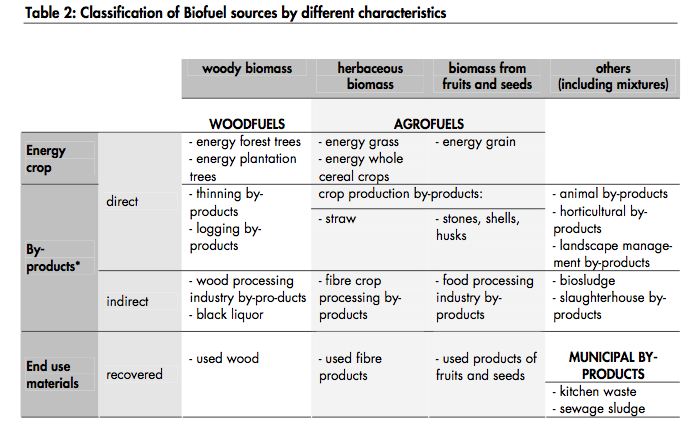Biofuels
Introduction
Biofuels are liquid or gaseous fuels produced from biomass that are generally high in sugar (such as sugarcane , sugarbeet , sweet sorghum) , starch (such as corn and cassava) or oils (such as soybeans, rapeseed, coconut, sunflowers, and palms).[1] The two most commonly used biofuels are ethanol and biodiesel.[2]
.
Classification of Biofuel Sources
Classification of Biofuel sources according to Food and Agricultural Organization (FAO)[3].
- *The term “by-products” includes the improperly called solid, liquid and gaseous residues and wastes derived from
Classification of biofuel according to generations
Biofuels are generally classified as first , second and third generations:
First-generation biofuels are made from sugar, starch, vegetable oil, or animal fats using conventional technology. These are generally produced from grains high in sugar or starch fermented into bioethanol; or seeds that which are pressed into vegetable oil used in biodiesel. Common first-generation biofuels include vegetable oils, biodiesel, bioalcohols, biogas, solid biofuels, syngas.
Second-generation biofuels are produced from non-food crops, such as cellulosic biofuels and waste biomass (stalks of wheat and corn, and wood). Common second-generation biofuels include vegetable oils, biodiesel, bioalcohols, biogas, solid biofuels, and syngas. Research continues on second-generation biofuels including biohydrogen, biomethanol, DMF, Bio-DME, Fischer-Tropsch diesel, biohydrogen diesel, mixed alcohols and wood diesel.
Third-generation biofuels are produced from extracting oil of algae – sometimes referred to as “oilgae”. Its production is supposed to be low cost and high-yielding – giving up to nearly 30 times the energy per unit area as can be realized from current, conventional ‘first-generation’ biofuel feedstocks.[4]
Biofuel: Ethanol
Ethanol (CH3CH2OH)is an alcohol fuel made from the sugars found in grains such as corn sorghum, barley and in plant products such as potato skins, rice, sugar cane, sugar beets , yard clippings , bark and switchgrass.[5]<o:p></o:p>
Ethanol can be produced by a process called gasification. Gasification systems use high temperatures and a low-oxygen environment to convert biomass into synthesis gas, a mixture of hydrogen and carbon monoxide. The synthesis gas, or "syngas," can then be chemically converted into ethanol and other fuels.[6] Ethanol is used in special engine by mixing with petrol and is called Gasohol (70-90% petrol and 10-30% ethanol). Currently, a blend of 10% ethanol and 90% gasoline called E10 is approved for use in all vehile. E10 was previously called Gasohol.[7]. Ethanol is generally used as a blending agent to increase octane adn cut down carbon monoxide and other smog-causing emissions. [8]
E10 was introduced into the German Market in 2011 following the EU guidelines of enviornmental protectiona and reduce dependency on fossil fuels. However E10 has received a lot of criticism in the market. The high water content in E10 is corrosive on metals ,mostly to aluminium. E 10 is also supposed to increase petrol consumption by 2%. Moroever , there is also a food vs fuel debate where people argue that producing E10 could lead to rising food prices. A counter arguement could be that E10 is eco friendly and reduces our dependence on fossil fuels.
Biodiesel
Biodiesel is made by combining alcohol (usually methanol) with vegetable oil, animal fat, or recycled cooking grease.
It can be used as an additive (typically 20%) to reduce vehicle emissions or in its pure form as a renewable alternative fuel for diesel engines.[9]It is the fastest growing alternative fuel in the United States. Biodiesel, a renewable fuel, is safe, biodegradable, and produces lower levels of most air pollutants than petroleum-based products[10]
References
- ↑ http://biofuelsandthepoor.com/facts-and-definitions/
- ↑ http://www.nrel.gov/learning/re_biofuels.html
- ↑ Unified Bioenergy Terminology ftp://ftp.fao.org/docrep/fao/007/j4504e/j4504e00.pdf, page 9
- ↑ http://biofuelsandthepoor.com/facts-and-definitions/
- ↑ http://www.eia.gov/energyexplained/index.cfm?page=biofuel_home
- ↑ http://www.nrel.gov/learning/re_biofuels.html
- ↑ www.energyfuturecoalition.org/biofuels/fact_ethanol.htm#1
- ↑ http://www.nrel.gov/learning/re_biofuels.html
- ↑ http://www.nrel.gov/learning/re_biofuels.html
- ↑ http://www.eia.gov/energyexplained/index.cfm?page=biofuel_home




















